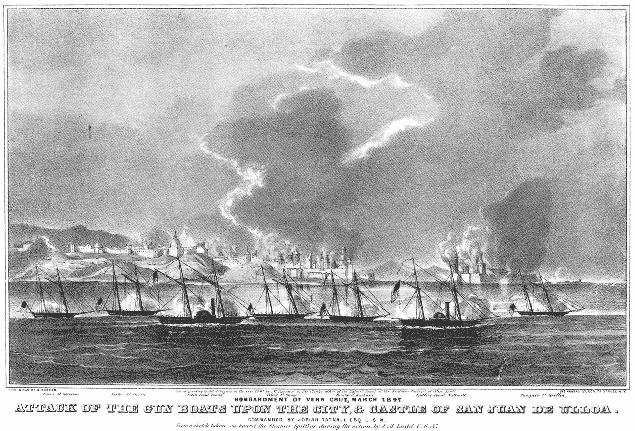

BOMBARDMENT OF VERA CRUZ
At the beginning of the Mexican War, the American Navy sorely lacked shallow-draft vessels that could operate along the shallow coastal waters and rivers of Mexico. In May, 1846 it purchased several small ships under construction from New York shipbuilder Brown & Bell. Two of these were the light-draft steamers Spitfire and Vixen, second and fifth from the right above. They were 118 feet long and 22½ feet on beam, drive by side wheels enclosed in large paddle boxes. Each carried a crew of 50. The Spitfire had one 8-inch Paixhans steel gun and two 32-pounder carronades; the Vixen, three 32-pount carronades. These were the best of the small steamers operating in the Gulf, but they handled poorly in rough seas and were subject to engine troubles. The print above also depicts three small schooners purchased from Brown & Bell: the Reefer (2nd from left); the Petrel (4th from left); and the Bonita (5th from left). Each was only 59 feet long, carried one 32-pounder carronade, and was manned by a crew of 40. Two other schooner-gunboats appear in the print: the Falcon (far left) and the Tampico (at far right). Formerly the Isabel and Pueblano, respectively, they were seized as prizes when the city of Tampico was captured on November 14, 1846.
To support the army at Vera Cruz, Commodore Perry dispatched the Mosquito Fleet
under Commodore Josiah Tatnall in the Spitfire. On March 22 and 23 these
ships took up
a position off Point Hornos on the east side of Vera Cruz, close to the city and the
castle
San Juan d'Ulloa. The artist, Midshipman James Ladd, was aboard the Spitfire.
After James M. Ladd. Hand-colored lithograph. N. Currier, NY. 1847.
Push your browser's back
button to return to the Site Menu.
If this page is in a frame, click below.